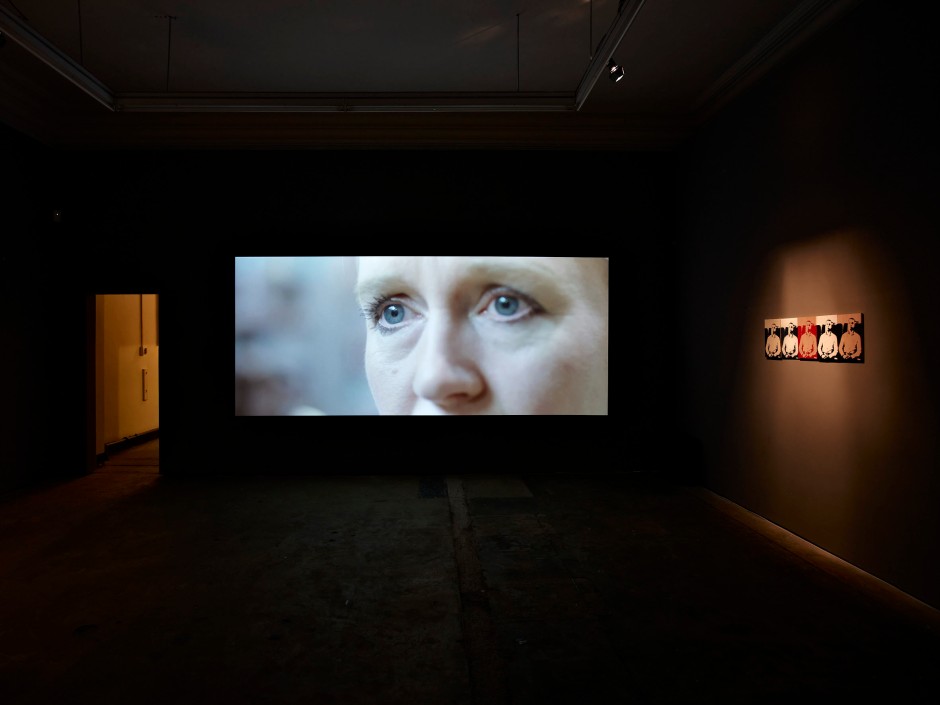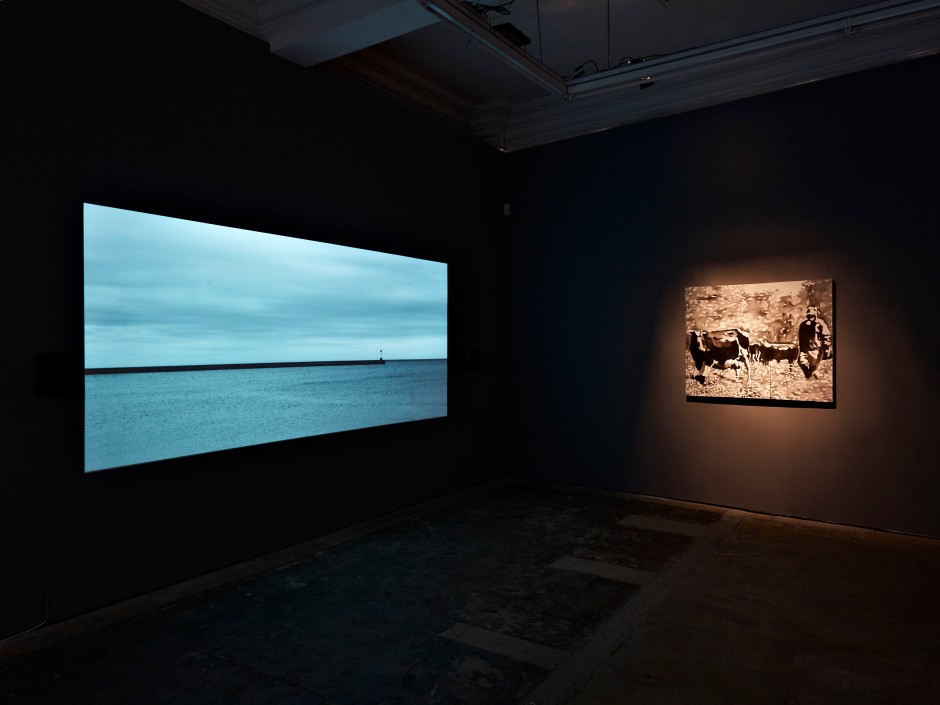Solo Exhibition, Workplace.
https://workplacefoundation.art/exhibitions/37/overview/
6th June -19th July 2014
PRESS RELEASE
‘Workplace Gallery is delighted to present Everyday Collateral our second solo exhibition by Swedish artist Cecilia Stenbom. Everyday Collateral brings together a series of recent works that explore anxiety, behaviour and the quest for control in public space. Working across media including Film, Painting, and Print Stenbom’s work examines individual methods and coping mechanisms used to navigate safely and comfortably through everyday life.
Stenbom’s recent Film works are shot with a distinct style, symmetry and production that echoes diverse influences from the iconic cinematography of the Mega American series Mad Men through to the wide angle, bleak landscapes of Scandinavian Television, whilst simultaneously retaining their roots in the balance between subtle irony and direct content of her early fixed camera performance videos. Set entirely within the confines of a generic shopping centre System follows the interactions between two sisters; one anxious about her personal safety, the other concerned with the invisible threat of infection. The sterile and repetitive atmosphere of the surrounding environment quickly becomes menacing as each character’s personal boundaries are compromised. The Case takes its starting point from popular crime fiction and in particular the opposing genres of Nordic (or Scandinavian) Noir and popular British TV crime drama. Set in the border town of Berwick-upon-Tweed The Case investigates how crime fiction preys and perpetuates anxiety whilst being a constant source of entertainment. In both works the scripts were developed through a series of public events and private conversations aimed at arming Stenbom with ‘real’ information. In System these conversations form the basis of an ultimately fictional relationship between sisters Cath and Laura, the main protagonists and in The Case all of the dialogue is constructed directly from carefully edited quotes from the public creating an engaging and unsettling tension in both works.
Alongside the film works Stenbom continues to use found imagery and material as the basis for a series of new paintings and print works. Fall Out for Farmers is a monochrome painting based on an image extracted from a Swedish information film from the mid 1980’s (soon after the Chernobyl Disaster) that was targeted to farmers, informing them of what to do in the event of nuclear fallout. Another painting entitled New Protocol presents an image taken from an 80’s news feature on the ‘new protocol’ adopted by the Swedish police in order to protect ‘The Force’ against the threat of HIV infection whilst working in ‘The Field’. Etiquette is a large Diptych screen print depicting two men at a Shooting Range. Using the same technique Workplace Safety is a small, detailed work that shows a man in an industrial interior standing with his arms outstretched. Both works originate from educational training videos, a genre Stenbom has often reinterpreted and appropriated in her work citing a fascination with “the dead pan nature of the presentations and their absolute conviction that whatever is being ‘instructed’ holds some kind of absolute truth.”
“For me the process of transforming and filtering found and captured material through a set of different processes is a way to create a sort of Chinese whispers where part of the meaning is transformed, lost or changed.” Cecilia Stenbom 2014
Cecilia Stenbom’s new work captures and explores human relationships, particularly the performed behaviors and interactions of everyday life and its relationship to the media. Prompting questions around how individuals deal with actual danger and imagined threat in a consumer driven and information saturated world and the fine line between justified safety measures and irrational fear.’
10 Commandments of Workplace Safety (2014)
Screen print on Perspex
20 x 30 x 1 cm
Photo by David Lawson
 Everyday Collateral, Installation view
Everyday Collateral, Installation view
Photo by David Lawson Everyday Collateral, Installation view
Everyday Collateral, Installation view
Photo by David Lawson
Fallout, 2014, Acrylic on canvas, 120 x 100 cm
Painting is based on a still image taken from a Swedish informational film from the early 1980’s targeted to farmers to know to do in the event of nuclear fallout.
Photo by David Lawson
Safety in numbers (2014)
2014
30cm x 100cm
Aquasheen ink, canvas, perspex, plywood, felt.
Photo by David Lawson
 Everyday Collateral, Installation view
Everyday Collateral, Installation view
Photo by David Lawson
Everyday Collateral, Installation view
Photo by David Lawson
Everyday Collateral, Installation view
Photo by David Lawson

Everyday Collateral, Installation view
Photo by David Lawson
Everyday Collateral, Installation view
Photo by David Lawson
Everyday Collateral, Installation view
Photo by David Lawson

Etiquette (2014)
95cm x 204 cm Aquasheen ink screen printed on perspex.

New Protocol, 2014, Acrylic on canvas, 120 x 100 cm
Painting is based on a still image taken of archive footage from early 1980’s in a news feature on the new protocol that the Swedish police had adopted in order to protect the force against the threat of HIV infection; protective glasses needed to be worn in hostile situations when dealing with known homosexuals and intravenous drug users.
Solo Exhibition, Workplace.
https://workplacefoundation.art/exhibitions/37/overview/
6th June -19th July 2014
PRESS RELEASE
‘Workplace Gallery is delighted to present Everyday Collateral our second solo exhibition by Swedish artist Cecilia Stenbom. Everyday Collateral brings together a series of recent works that explore anxiety, behaviour and the quest for control in public space. Working across media including Film, Painting, and Print Stenbom’s work examines individual methods and coping mechanisms used to navigate safely and comfortably through everyday life.
Stenbom’s recent Film works are shot with a distinct style, symmetry and production that echoes diverse influences from the iconic cinematography of the Mega American series Mad Men through to the wide angle, bleak landscapes of Scandinavian Television, whilst simultaneously retaining their roots in the balance between subtle irony and direct content of her early fixed camera performance videos. Set entirely within the confines of a generic shopping centre System follows the interactions between two sisters; one anxious about her personal safety, the other concerned with the invisible threat of infection. The sterile and repetitive atmosphere of the surrounding environment quickly becomes menacing as each character’s personal boundaries are compromised. The Case takes its starting point from popular crime fiction and in particular the opposing genres of Nordic (or Scandinavian) Noir and popular British TV crime drama. Set in the border town of Berwick-upon-Tweed The Case investigates how crime fiction preys and perpetuates anxiety whilst being a constant source of entertainment. In both works the scripts were developed through a series of public events and private conversations aimed at arming Stenbom with ‘real’ information. In System these conversations form the basis of an ultimately fictional relationship between sisters Cath and Laura, the main protagonists and in The Case all of the dialogue is constructed directly from carefully edited quotes from the public creating an engaging and unsettling tension in both works.
Alongside the film works Stenbom continues to use found imagery and material as the basis for a series of new paintings and print works. Fall Out for Farmers is a monochrome painting based on an image extracted from a Swedish information film from the mid 1980’s (soon after the Chernobyl Disaster) that was targeted to farmers, informing them of what to do in the event of nuclear fallout. Another painting entitled New Protocol presents an image taken from an 80’s news feature on the ‘new protocol’ adopted by the Swedish police in order to protect ‘The Force’ against the threat of HIV infection whilst working in ‘The Field’. Etiquette is a large Diptych screen print depicting two men at a Shooting Range. Using the same technique Workplace Safety is a small, detailed work that shows a man in an industrial interior standing with his arms outstretched. Both works originate from educational training videos, a genre Stenbom has often reinterpreted and appropriated in her work citing a fascination with “the dead pan nature of the presentations and their absolute conviction that whatever is being ‘instructed’ holds some kind of absolute truth.”
“For me the process of transforming and filtering found and captured material through a set of different processes is a way to create a sort of Chinese whispers where part of the meaning is transformed, lost or changed.” Cecilia Stenbom 2014
Cecilia Stenbom’s new work captures and explores human relationships, particularly the performed behaviors and interactions of everyday life and its relationship to the media. Prompting questions around how individuals deal with actual danger and imagined threat in a consumer driven and information saturated world and the fine line between justified safety measures and irrational fear.’
10 Commandments of Workplace Safety (2014)
Screen print on Perspex
20 x 30 x 1 cm
Photo by David Lawson
 Everyday Collateral, Installation view
Everyday Collateral, Installation view
Photo by David Lawson Everyday Collateral, Installation view
Everyday Collateral, Installation view
Photo by David Lawson
Fallout, 2014, Acrylic on canvas, 120 x 100 cm
Painting is based on a still image taken from a Swedish informational film from the early 1980’s targeted to farmers to know to do in the event of nuclear fallout.
Photo by David Lawson
Safety in numbers (2014)
2014
30cm x 100cm
Aquasheen ink, canvas, perspex, plywood, felt.
Photo by David Lawson
 Everyday Collateral, Installation view
Everyday Collateral, Installation view
Photo by David Lawson
Everyday Collateral, Installation view
Photo by David Lawson
Everyday Collateral, Installation view
Photo by David Lawson

Everyday Collateral, Installation view
Photo by David Lawson
Everyday Collateral, Installation view
Photo by David Lawson
Everyday Collateral, Installation view
Photo by David Lawson

Etiquette (2014)
95cm x 204 cm Aquasheen ink screen printed on perspex.

New Protocol, 2014, Acrylic on canvas, 120 x 100 cm
Painting is based on a still image taken of archive footage from early 1980’s in a news feature on the new protocol that the Swedish police had adopted in order to protect the force against the threat of HIV infection; protective glasses needed to be worn in hostile situations when dealing with known homosexuals and intravenous drug users.





